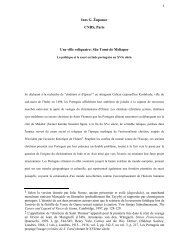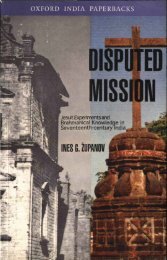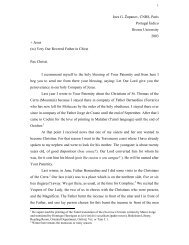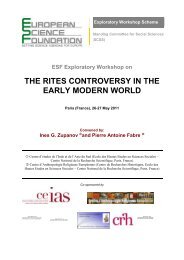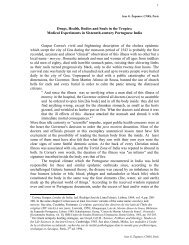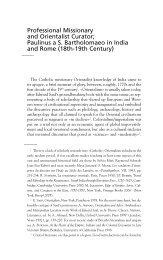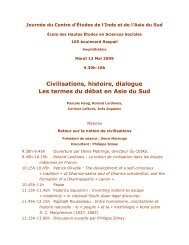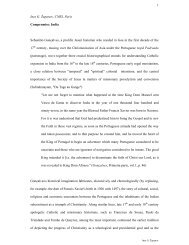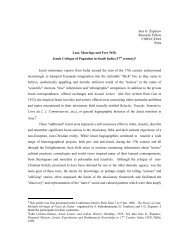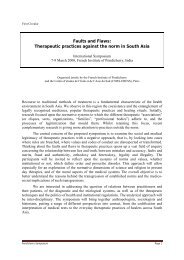Jesuit Orientalism; - Ines G. Županov
Jesuit Orientalism; - Ines G. Županov
Jesuit Orientalism; - Ines G. Županov
You also want an ePaper? Increase the reach of your titles
YUMPU automatically turns print PDFs into web optimized ePapers that Google loves.
egin”. 78 The attack on Buddhist “scriptures” by diagnosing its rhetorical feebleness provides an<br />
24<br />
It is obvious that the text was presented - truncated as it was and finally only a<br />
translation of a Chinese text that was not included – as if it encapsulated an objective<br />
transposition of pagan ideas and even its wording. It was the “style” that Pereira reportedly<br />
changed to avoid “confusion” because, in his opinion, in spite of their “many thousand letters,<br />
they do not go further than our students of Rhetoric” and “they end where Europeans<br />
epistemic diversion away from Pereira‟s main method of coating the paraphrase into<br />
relentless refutation operated by way of comparison. 79 While comparison with European<br />
Christian texts and institutions was an accepted strategy of measuring the extent of and<br />
separating “false” from “true”, in <strong>Jesuit</strong> pedagogical language it was commonly allowed to<br />
explore and compare different shades and degrees of the “false”. In their overseas missions,<br />
<strong>Jesuit</strong>s were in fact forced to compare one type of pagan tradition with another. One of the<br />
immediate results was the sharpening of <strong>Jesuit</strong> genealogical and historicist thinking.<br />
When, in the beginning of Pereira‟s letter, the writer expressed his hopes that Queiros<br />
would be able “by comparison to discover the falsity” of Chinese scriptures, it is left<br />
ambiguous with what they are to be compared. Surely, he did not have to mention the fact that<br />
the ultimate measuring rod is the Christian Bible. An immediately useful comparison may<br />
have been, in Pereira‟s view, with Indian, more ancient, Buddhist texts.<br />
The book he translated into Portuguese was, according to Pereira, a “translation made<br />
with great authority by Bonzes from India and by learned Chinese”. 80 Who would know more<br />
about translation and its predicament than the experienced missionary linguists? Especially<br />
those in China and India working under the banner of accommodation, were familiar with the<br />
problems of transposing meanings from one cultural system into another. To what degree was<br />
Pereira ready to think about parallelism between the missionaries who introduced Buddhism<br />
to China and his own Catholic missionary goals? It is difficult to think that he did not notice<br />
it, but he had a different point to make: that Buddhism in China was a derivative religion and<br />
it was adapted to Chinese taste.<br />
Pereira highlights some of these “adaptations”: The titles and dignities of Chinese<br />
kings were given to Indian kings; Buddha is given a Chinese burial in which he is placed in a<br />
78 Queiros, 109.<br />
79 Queiros, p. 95.<br />
80 Queiros, p. 109.




